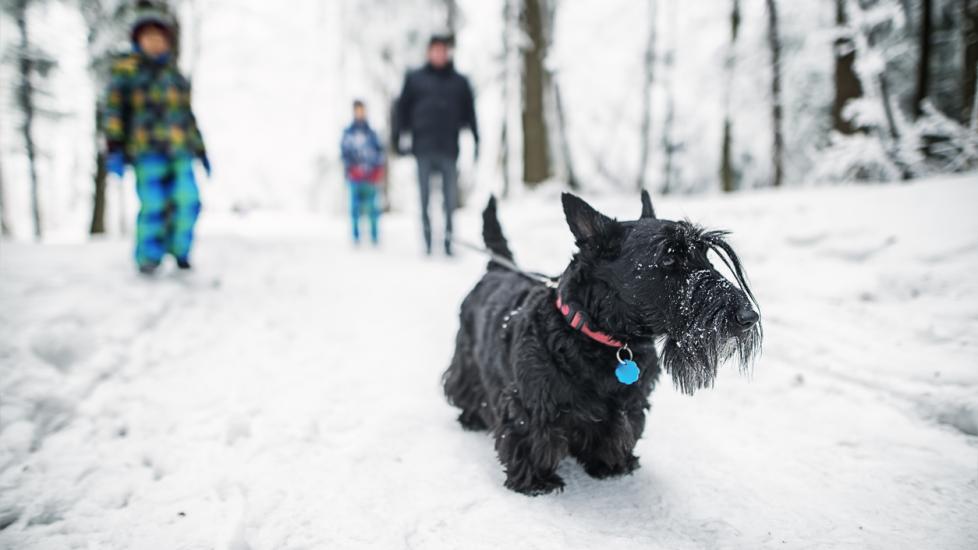How To Protect Dog Paws in Winter
The following may contain Chewy links. PetMD is operated by Chewy.
Winter is a great season to spend time outside with our dogs. Many prefer cold temperatures to hot and love having a chance to romp in the snow. But pet parents need to take some extra precautions to keep dogs safe in the winter, and this includes finding the right type of paw protection.
Why Do You Need To Protect Your Dog’s Paws in Winter?
Dog paws bear the brunt of dangers associated with winter weather:
-
Sharp ice can cut deeply.
-
Snow forms painful clumps that can lodge between paw pads and in the fur around a dog’s feet.
-
Dampness increases the risk of frostbite.
-
A lack of traction may lead to slips, falls, strains, and sprains.
-
Ice-melting chemicals can irritate the skin or lead to digestive upset if licked from the fur. Large ingestions can even cause muscle tremors and seizures.
These risks increase the longer dogs are outside and the more miles they travel. When there’s snow and ice on the ground, it’s worth considering paw protection for anything other than the shortest jaunt outside.
The Best Way To Protect Your Dog’s Paws in Winter: Use Booties
Dog snow boots are the most reliable way to protect paws in winter. They provide a nearly impenetrable barrier against sharp ice, snow, dampness, and chemicals and can help with traction. The best doggie boots for winter are:
-
Lightweight
-
Easy to get on and off
-
Adjustable and come in a wide variety of sizes to ensure a snug but comfortable fit
-
Made from durable, waterproof, breathable materials
-
Easy to clean
-
Nonslip
When it comes to selecting the right bootie for your pup, Muttluks Trackers All-Season Dog Boots, Kurgo Blaze Cross Dog Shoes, and Muttluks Original Fleece-Lined Winter Dog Boots are all good options, but doggie shoes for winter do take some getting used to! Start by putting them on your dog in the house for just a few minutes. Gradually build up to taking short and then longer walks outside, and be sure to give your dog lots of treats and praise.
Always remove dog snow boots once you’re inside so your dog doesn’t get uncomfortably warm or have the chance to lick chemicals off the exterior of the boots. Leaving them on for too long can also cause painful pressure sores.
Other Methods for Keeping Your Dog’s Paws Protected
While doggie boots for winter offer the best protection against the elements, they aren’t right for every dog or in every situation. Thankfully, pet parents have some other good choices.
Use Paw Balm
Paw balms like Musher's Secret Paw Protection Natural Dog Wax won’t protect dogs from sharp ice, but they form a protective barrier against dampness and chemicals and prevent snow from clumping between paw pads and toes. Good paw balms also contain ingredients that are moisturizing and soothing to a dog’s feet.
To use, apply a thin layer of balm on and between your dog’s paw pads, between their toes, and on the fur on the sides of the feet. You’ll want to do this outdoors or in a garage so your dog doesn’t track the paw balm around your house. Place a towel next to your door so you can wipe any chemicals or excess balm off your dog’s feet before you let them back indoors. Paw balms may need to be reapplied if you’re outside with your dog for a long time.
Carry a Towel
If you’re just heading out for a short walk, you may simply want to carry a hand towel or grooming glove along with you. You can use it to wipe chemicals from your dog’s feet, remove any clumps of snow that form, and dry off your dog’s paws before coming back inside. Repeatedly stopping to wipe your dog’s feet during a long walk can get annoying, but for just a quick trip outside, a hand towel may be all you need.
Shovel a Set Path
If you’re lucky enough to have access to a yard, shoveling a path for your dog to use can make potty breaks easier for everyone. Of course, you’ll probably still want to go out for a walk around the neighborhood and your dog may decide to wander off the path you’ve provided, so shoveling won’t solve all your problems, but it can help.
Don’t let cold weather stop you and your dog from enjoying time outdoors. With a little preparation, winter can be safe for dogs and a whole lot of fun.
Featured Image: iStock/Imgorthand
